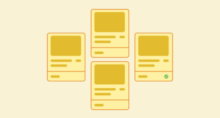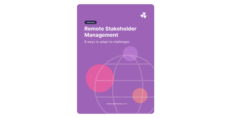Monitor Stakeholder Engagement: A 5-Step Process

Monitoring stakeholder engagement is a critical part of the engagement and project management process… and it’s the part that most often gets skipped over.
Properly monitoring for results isn’t easy. It requires planning, forethought, systems, and a bit of time. But it’s well worth doing if you want to become better at engaging stakeholders — not just in your current project, but for future projects, too.
Ready to do a better job of monitoring your stakeholder engagement? This guide includes everything you need to know, including definitions, why it matters, what you can monitor, and how to monitor your engagement in five steps.
What Does It Mean to Monitor Stakeholder Engagement?
In case you’re new to stakeholder engagement monitoring, let’s start with some basic definitions.
A stakeholder is the people or groups who are impacted by, have an influence on, or an interest in a project, initiative, policy or organization.
And stakeholder engagement refers to the process of engaging with your stakeholders — such as identifying them, consulting with them about your project, building relationships, and encouraging their participation and feedback.
Stakeholder engagement monitoring refers to the part of the engagement process where you keep track of stakeholders, how you’re engaging with them, and any results of your engagement.
This could be as simple as keeping record of the number of people you’ve engaged with throughout the project period. But more often, it involves keeping track of each stakeholder and each interaction, and analyzing them to understand how well your engagement is going (and what you could do better).
6 Reasons It’s Worth Monitoring Stakeholder Engagement

Monitoring stakeholder engagement sounds like a lot of work, right? Well, it can be. But it’s worth the effort! Here are six reasons why you shouldn’t skip this step…
1. See Change
Perhaps the most obvious reason to monitor your stakeholder engagement is that there should be some changes as a result of your engagement. Changes like… greater community awareness, increased stakeholder support, and bringing new ideas and perspectives into your project. Monitoring allows you to see those changes and report on them.
2. Identify Cause and Effect
You might get some results, but if you don’t monitor your engagement closely, you may not know why you’re getting them. Effective monitoring (with pre-defined measures that match up with your objectives) can help you show what actions or decisions led to specific results, whether good or bad.
3. Adjust Your Course
When you monitor stakeholder engagement — especially while you’re still in the process of engaging — you can confirm whether you’re on track to succeed with your goals and make any necessary adjustments to get back on track.
4. Learn More, Do Better
Stakeholder engagement monitoring can help you evaluate how your engagement process is going. You can learn more about what’s working, what’s not working, and how you can do a better job next time.
5. Keep Stakeholders Engaged
In some projects, it is critical that stakeholders remain consistently engaged in the process. You may rely on them for feedback or some other contribution. By monitoring their level of support, their sentiments towards the project, their satisfaction, any concerns or issues that come up, and how often they’re engaging, you can identify which relationships you may need to focus on in order to retain or gain their engagement.
6. Succeed With Your Project
A lot of the time project success can depend on having satisfied stakeholders. And to satisfy your stakeholders, you’ll generally need to meet their expectations and needs. But stakeholder expectations and needs are not fixed — even if you identify them at the start of your project, it’s a good idea to monitor your stakeholders for any changes so that you can stay aligned.
What Can You Monitor?
You can monitor quite a lot of different data and indicators — it all depends on what’s relevant to your goals, objectives, and stakeholders. But to help you start thinking about what you might monitor, here are a few ideas:
- Goals – Track whether you’re getting closer to the goals and objectives stated within your stakeholder engagement plan
- Best practices – Track whether your engagement lines up with stakeholder engagement principles and best practices.
- Obligations – Track whether you’re meeting any legal obligations, on track to pass potential audits, and upholding human rights.
- Interests – Instead of just monitoring a generic set of indicators, you could monitor data relevant to your stakeholder interests (along with locally relevant key issues) in order to address them.
- Process – Monitor the overall process of the stakeholder engagement, its outcomes, your outputs, timelines, and any unintended consequences.
Note: you can’t necessarily monitor or track a goal, process, obligation, or interest in its most basic form. But you can look for indications that you’re achieving the goal, and qualitative/quantitative data that points to those indications. For instance, if your goal is to improve the quality of your policy/program, an indicator might be less conflict around the suggested improvements, and you could monitor this by tracking the number of complaints or objections submitted.
Monitor Stakeholder Engagement: A 5-Step Process

The process of monitoring stakeholder engagements will vary between projects, but in general, you’ll need to start with objectives, make a plan, gather feedback and data, and then analyze it. We’ve broken down each of these steps below.
Step One: Set Objectives
The first step to monitor stakeholder engagement is to identify what goals (and therefore, what data) you need to monitor. We’ve already covered plenty of ideas in the previous section, but the best place to start is usually with your stakeholder engagement objectives. So if you haven’t already, clearly define your objectives in a written stakeholder engagement plan.
Step Two: Plan for Monitoring
As part of your stakeholder engagement plan, touch upon how you’ll monitor and evaluate your engagement, so that you can put systems in place from the start. This includes developing indicators for your goals/objectives and what qualitative/quantitative data you’ll monitor in order to track your results.
At this point, it’s also a good idea to note down who might be responsible for your stakeholder engagement monitoring and reporting. After all, it’s not something that’s likely to happen on its own — it takes time and effort to monitor and evaluate your engagements.
Step Three: Gather Feedback
Regardless of your objectives, you’ll likely need to gather at least some feedback in order to monitor and evaluate your engagement. Gathering feedback can include official surveys and polls, or it could include unofficial comments, emails, and conversations. Some standard questions you might like to ask include:
- How do you feel about the project or engagement?
- What is going well?
- What is not going well?
- If you could change anything about the project or engagement, what would it be?
By asking these same questions at the start of the engagement, as well as at specific milestones or regular intervals during the project, you can monitor how your stakeholders’ feelings change over time, and take action based on their feedback.
Step Four: Track Everything
A huge part of stakeholder monitoring is good data management practices. This means tracking absolutely everything, ideally in one location, so that you can build a complete picture of your engagement for monitoring, analysis, and evaluation. Especially if you’re collaborating with other team members. The type of data you should be tracking includes:
- Who your stakeholders are
- Location
- Level of impact, influence, and interest
- Specific stakeholder interests
- Form and survey responses
- Emails (sent and received)
- Comments
- Conversations
- Complaints
- Events/meetings
- Relationships between stakeholders
- Any other interactions
Step Five: Analyze, Evaluate & Report
The last step in monitoring is to pull together all the feedback you’ve gathered and the data you’ve tracked, then analyze your findings to make sense of the data. Depending on what you need to track and measure, this could involve:
- Running qualitative analysis to identify issues, themes, and sentiments
- Creating stakeholder maps so you can visualize changes to stakeholder attributes (before, during, and after the engagement)
- Generating charts that show how your engagement is impacting stakeholders
- Adding up numbers or calculating percentage increase/decrease in specific data
- Calculating stakeholder support/sentiment scores overall, and for specific segments
Use your analysis to generate reports that you can share with relevant parties (maybe even your stakeholders) and update your plan to reflect any necessary changes to your engagement.
Engagement Monitoring Tools & Techniques

Monitoring your engagement is much easier (and less time consuming) when you’ve got the right tools to support the process. Here are a few stakeholder engagement tools and techniques we recommend:
Spreadsheets
Spreadsheets are a great starting point for smaller stakeholder engagements. If you only have a small number of stakeholders and interactions to monitor, you could keep track of them in a spreadsheet. However, if the volume of data you’re tracking starts to get messy, or you get frustrated with the limitations of spreadsheets, it might be time to upgrade to purpose-built stakeholder software (more on this below!).
Stakeholder Analysis
Stakeholder analysis is an essential technique for understanding your stakeholders, the data you need to track, and how you can get insights from it.
Stakeholder Mapping & Data Visualization
Stakeholder mapping is another essential technique, as it can allow you to visualize your stakeholder data in charts. You can produce stakeholder maps for the same set of data at different points in time to show the impact of your consultation or project. For instance, you could plot your stakeholders’ level of support, relationships, impact, or influence at the start of the project, and at the end of the project, and then compare the two.
Stakeholder Sentiment
Stakeholder sentiment is about how your stakeholders feel towards your organization or project. Do they feel positively, negatively, or neutral? You can analyze stakeholder sentiment by looking at the implied feeling behind the words your stakeholders use in conversations, comments, emails, and feedback forms. It gets really interesting when a stakeholder regularly interacts with you throughout the engagement — sentiment analysis can show you how their feelings change over time!
Issues Tracking
Similarly, you can determine the issues your stakeholders care about by looking at the contents of their conversations, comments, emails, and feedback submissions. If they keep mentioning traffic noise, it’s probably an issue for them. If you start to see mentions of light pollution across a specific stakeholder group, something in your project has likely changed to trigger it.
Feedback Surveys
Form software or survey platforms can be useful tools for stakeholder engagements and monitoring. The best ones should help you analyze the data qualitatively and quantitatively so that you can easily determine issues and sentiments!
Stakeholder Software
Last but not least, perhaps the best tool for monitoring your engagement is stakeholder software! That’s because the right software should help you do all of the above. This means you don’t have to move your data around between different pieces of software, and you can put a lot of your stakeholder monitoring on autopilot.
Simply Stakeholders includes built-in issues tagging (done-for-you), AI-generated sentiment analysis scores, relationship scoring, stakeholder mapping, survey forms, reports, and notifications. You can even set up workflows and let us monitor your stakeholders for you — then we’ll let you know when it’s time to reach out!
Simplify Stakeholder Monitoring with Simply Stakeholders
Ready to simplify your stakeholder monitoring process? Learn more about Simply Stakeholders or contact our team — we’d love to take you through a personalized demo.






























